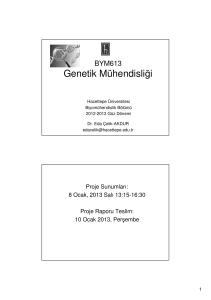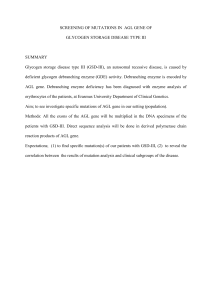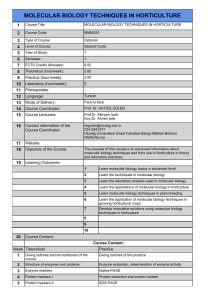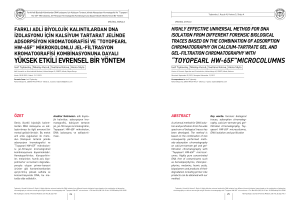Purification and recovery of invertase from potato tubers (Solanum
advertisement
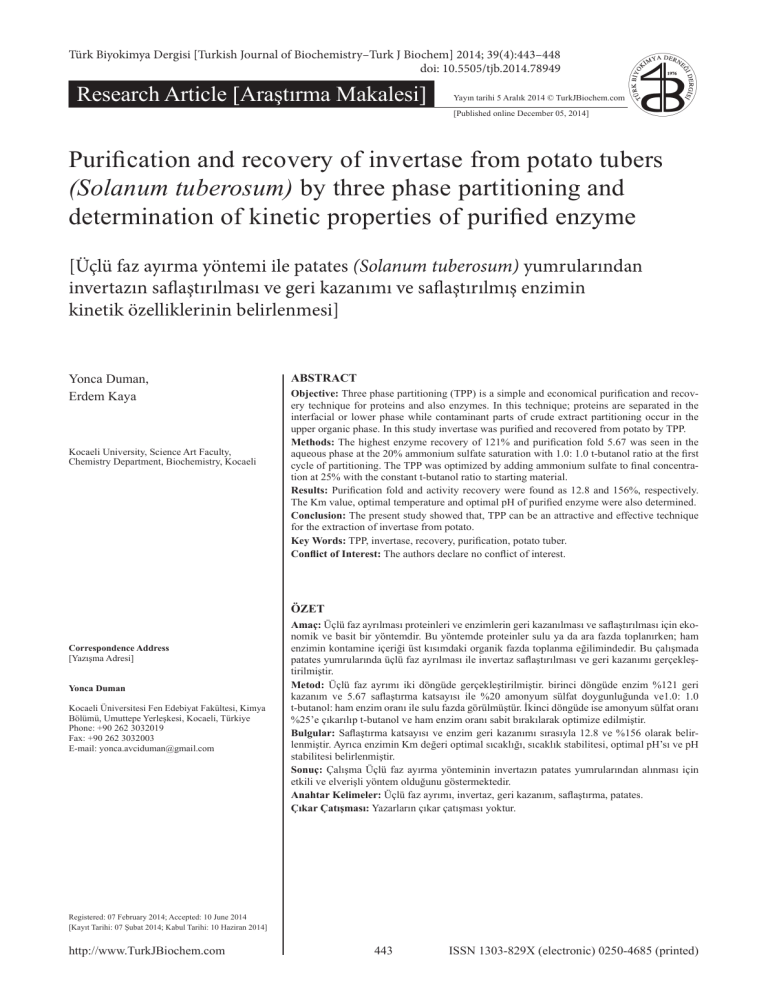
Türk Biyokimya Dergisi [Turkish Journal of Biochemistry–Turk J Biochem] 2014; 39(4):443–448 doi: 10.5505/tjb.2014.78949 Research Article [Araştırma Makalesi] Yayın tarihi 5 Aralık 2014 © TurkJBiochem.com [Published online December 05, 2014] Purification and recovery of invertase from potato tubers (Solanum tuberosum) by three phase partitioning and determination of kinetic properties of purified enzyme [Üçlü faz ayırma yöntemi ile patates (Solanum tuberosum) yumrularından invertazın saflaştırılması ve geri kazanımı ve saflaştırılmış enzimin kinetik özelliklerinin belirlenmesi] Yonca Duman, Erdem Kaya Kocaeli University, Science Art Faculty, Chemistry Department, Biochemistry, Kocaeli ABSTRACT Objective: Three phase partitioning (TPP) is a simple and economical purification and recovery technique for proteins and also enzymes. In this technique; proteins are separated in the interfacial or lower phase while contaminant parts of crude extract partitioning occur in the upper organic phase. In this study invertase was purified and recovered from potato by TPP. Methods: The highest enzyme recovery of 121% and purification fold 5.67 was seen in the aqueous phase at the 20% ammonium sulfate saturation with 1.0: 1.0 t-butanol ratio at the first cycle of partitioning. The TPP was optimized by adding ammonium sulfate to final concentration at 25% with the constant t-butanol ratio to starting material. Results: Purification fold and activity recovery were found as 12.8 and 156%, respectively. The Km value, optimal temperature and optimal pH of purified enzyme were also determined. Conclusion: The present study showed that, TPP can be an attractive and effective technique for the extraction of invertase from potato. Key Words: TPP, invertase, recovery, purification, potato tuber. Conflict of Interest: The authors declare no conflict of interest. ÖZET Correspondence Address [Yazışma Adresi] Yonca Duman Kocaeli Üniversitesi Fen Edebiyat Fakültesi, Kimya Bölümü, Umuttepe Yerleşkesi, Kocaeli, Türkiye Phone: +90 262 3032019 Fax: +90 262 3032003 E-mail: [email protected] Amaç: Üçlü faz ayrılması proteinleri ve enzimlerin geri kazanılması ve saflaştırılması için ekonomik ve basit bir yöntemdir. Bu yöntemde proteinler sulu ya da ara fazda toplanırken; ham enzimin kontamine içeriği üst kısımdaki organik fazda toplanma eğilimindedir. Bu çalışmada patates yumrularında üçlü faz ayrılması ile invertaz saflaştırılması ve geri kazanımı gerçekleştirilmiştir. Metod: Üçlü faz ayrımı iki döngüde gerçekleştirilmiştir. birinci döngüde enzim %121 geri kazanım ve 5.67 saflaştırma katsayısı ile %20 amonyum sülfat doygunluğunda ve1.0: 1.0 t-butanol: ham enzim oranı ile sulu fazda görülmüştür. İkinci döngüde ise amonyum sülfat oranı %25’e çıkarılıp t-butanol ve ham enzim oranı sabit bırakılarak optimize edilmiştir. Bulgular: Saflaştırma katsayısı ve enzim geri kazanımı sırasıyla 12.8 ve %156 olarak belirlenmiştir. Ayrıca enzimin Km değeri optimal sıcaklığı, sıcaklık stabilitesi, optimal pH’sı ve pH stabilitesi belirlenmiştir. Sonuç: Çalışma Üçlü faz ayırma yönteminin invertazın patates yumrularından alınması için etkili ve elverişli yöntem olduğunu göstermektedir. Anahtar Kelimeler: Üçlü faz ayrımı, invertaz, geri kazanım, saflaştırma, patates. Çıkar Çatışması: Yazarların çıkar çatışması yoktur. Registered: 07 February 2014; Accepted: 10 June 2014 [Kayıt Tarihi: 07 Şubat 2014; Kabul Tarihi: 10 Haziran 2014] http://www.TurkJBiochem.com 443 ISSN 1303-829X (electronic) 0250-4685 (printed) Introduction Determination of invertase activity Invertase (β-fructofuronosidase E.C. 3.2.1.26) is a glycoenzyme that hydrolysis the terminal non-reducing β-fructofuronoside residues in β-D-fructofuronoside, like sucrose [1]. Invertase is found in many plants and it is a key enzyme for the carbohydrate mobilization as sucrose is catalyzed irreversibly by invertase into glucose and fructose residues which are main carbon source in plant metabolism [2-5]. This enzyme has many applications in cosmetics, pharmaceutical, paper but especially food and beverage industries [6-8]. Invertase was firstly isolated from yeast more than a century ago [3]. From the date until now researchers reported several purification methods that involve salt precipitation, different chromatographic techniques and ultrafiltration etc. which are led to low yields. They were also unscalable, time consuming, expensive multistep protocols [2-5,9-12]. Three phase partitioning has relatively recent use for bioseperation of enzymes and inhibitors [13-17]. It uses ammonium sulfate with certain saturation to precipitate the protein and tbutanol is added to make three phase layers and to remove lipids, phenolic compounds and some detergents [13,18]. The addition of t-butanol in the presence of ammonium sulfate pushes the protein out of the solution [13]. It is believed that the power of the separation is due to collective operation of conventional salting out, isoionic-osmolytic precipitation and hydration shifts of proteins [19]. There is no report about using TPP to separate invertase from potato; therefore this work was performed for purification and recovery of invertase by TPP. This method has an important potential use in various industries. 800 µL substrate (50 mM sucrose in 50 mM pH 4.7 acetate buffer) and 200 µL suitably diluted enzyme solution were taken in a test tube (extinction coefficient of o-sucrose equals to 2.568x103 M-1 cm-1). The reaction was incubated at 37 ºC for 30 min then was stopped by adding 0.1 ml of DNS (3,5-Dinitrosalicylic acid) reagent. The mixture was heated in a boiling water bath for 5 min. It was then cooled in ice bath and the amount of reducing sugars was measured spectrophotometrically at 540 nm [22]. The data presented for all invertase activity determinations are mean values of duplicate assay. One unit of invertase activity was defined as the amount of enzyme which released 1 µmole of glucose from sucrose per minute at pH 4.7 and 37 ºC. Protein concentration Concentration of the protein was determined by Bradford method [23] using Coomassie brilliant blue G-250 dye as a reagent and bovine serum albumin (BSA) as standard, by measuring the absorbance at 595nm at 25 ºC. Assays were performed in duplicate and the averages were used in calculations. Three-phase partitioning Effect of t-butanol TPP experiments were carried out by employing various t-butanol ratios (crude extract:t-butanol; 1.0:0.5, 1.0:1.0, 1.0:1.5, 1.0:2.0) with a constant ammonium sulfate saturation at 20% (w/v). The mixture was mixed gently and then allowed to stand for 30 min at 37 ºC. Afterwards the mixture was centrifuged at 5000 rpm for 10 min at +4 ºC to facilitate the separation of phases. The lower aqueous phase and the interfacial phase were collected and dialyzed against 50 mM pH 5 citrate buffer overnight at +4 ºC. Each of phases was analyzed for enzyme activity and protein content. The experimental conditions at which the highest enzyme activity observed were selected for the further experiments. Material and Methods Materials Sucrose and t-butanol were pure grade and purchased from Merck (Darmstadt, Germany), ammonium sulfate and Coomassie Brillant Blue R-250 were purchased from Sigma Chem. Co. (St. Louis, MO, USA), potato (Solanum tuberosum) was purchased from Kocaeli city, Akmeşe region, Turkey. All other chemicals and reagents were pure grade. Effect of ammonium sulfate saturation The effect of different ammonium sulfate saturations (20, 30, 40, 50, 60, 70%) (w/v) were also investigated at the best recovery activity crude enzyme:t-butanol ratio is obtained from section 2.3.1. The bottom phase and interfacial phase were collected and dialyzed against 50 mM pH 5 citrate buffer overnight at +4 ºC. Each of phases was analyzed for enzyme activity and protein content. The highest enzyme recovery was chosen for the further experiments. Preparation of crude extract Fresh potato roots were washed thoroughly with distilled water and then the peels were removed. Twenty gram roots were than cut into small pieces and then blended in 40 mL, 50 mM pH 5 acetate buffer with, containing 0.8 M sodium sulfate and 0.1 mM EDTA at +4 ºC for a minute. The homogenate was filtered from five layers of cheese cloth, then centrifuged at 10000 rpm for 20 min at +4 ºC [5,21]. The clear supernatant was treated as the crude enzyme extract for the further study (protein amount and specific activity was determined as 1.59 mg/mL and 0.57 U/mg, respectively). Turk J Biochem 2014; 39(4):443-448 Optimization of TPP conditions For the second cycle of TPP, the highest activity recovery of aqueous phase from the first cycle was used for optimization of TPP conditions. Selected phase wasn’t 444 Duman and Kaya dialyzed [25,26]. t-butanol in ratio of 1.0:1.0 was added, than saturated with the different ammonium sulfate to final concentrations of 25, 30, 35, 40, 45, 50%. The enzyme recovery and protein content of phases were analyzed as previously mentioned. However in some cases the target protein is recovered from aqueous phase [28]. This reason requires the second cycle TPP with the use of first cycle TPP’s aqueous phase as the starting material [29]. Fig. 1 shows the enzyme recovery and the protein content of aqueous phase at the different t-butanol ratios for the constant 20% (w/v) ammonium sulfate saturation. It is observed that t-butanol gave maximum recovery of invertase in 1.0:1.0 ratios with maximum fold purification and recovery 5.67 and 121%, respectively. Interestingly, an increase of t-butanol ratio caused a fully decrease of purification and activity recovery of invertase in the aqueous phase. If the tbutanol ratio is high, the denaturation of protein is more possible [18]. This may be attributed to synergetic effects of the increase in concentration of t-butanol and decrease in saturation of ammonium sulfate [25,26]. Figure 2a depicts the best saturation of ammonium sulfate concentration for the recovery and purification fold of invertase in aqueous phase for the first cycle of TPP. Generally one starts with a minimum salt saturation of 20% (w/v) and optimizes this so as to obtain maximum purification fold and recovery [15,16,25]. In this study invertase recovery of 121% yield and 5.67 folds purification were obtained in the aqueous phase at 20% saturation of ammonium sulfate with the 1.0:1.0 crude enzyme:t-butanol ratio. For all the ammonium sulfate saturations there was no enzyme activity in the interfacial phase. This finding was led to work completely in aqueous phase to second cycle of TPP. Increasing concentrations of ammonium sulfate resulted in decreasing of invertase recovery in aqueous phase. The high concentration of salt might decrease the selectivity of partitioning thus reduce recovery of enzyme [26]. Sodium dodecyl sulfate-polyacrylamide gel electrophoresis (SDS-PAGE) Molecular weight of purified invertase was determined by SDS-PAGE according to the method of Laemmli [24] on a Biorad Mini Protean electrophoresis unit. Electrophoresis was carried out at 100 mV for 120 min in citrate buffer (pH4.7) and 12% polyacrylamide gel system. For each lane 20µg protein was applied. The gel was stained with Coomassie Brilliant Blue R-250 for 1 hour then destained by 40% methanol and 10% acetic acid for 2 h. Kinetic studies Purified and recovered enzyme preparation was used for kinetic studies. The pH stability of enzyme was determined by incubation of enzyme for 1 h at 37 ºC at various pH, using 25 mM concentrations of the following buffer systems: glycine-HCl (pH 2.0, 3.0), sodium acetate (pH 4.0, 5.0, 6.0), sodium phosphate (pH 7.0, 8.0) and glycineNaOH (pH 9.0, 10.0), followed by assay of the remaining activity at pH 4.5 as described section 2.2.2. The relative activities (as percentage) were expressed as the ratio of the invertase activity obtained at a certain pH to the maximum activity obtained in the given pH range. The optimal pH for activity was determined by measuring the activity of enzyme in 50 mM sucrose with the same buffers at various pH at 37°C. In order to define the optimal temperature of enzyme against sucrose, different temperatures ranging from 25 to 60 ºC (25, 30, 35, 40, 45, 50, 55, 60) were assayed. After incubation periods, enzyme was assayed at standard activity conditions for determining the relative activity. The relative activity (as percentage) was expressed as the ratio of the invertase activity obtained at a certain temperature to the maximum activity obtained in the given temperature range. Michaelis-Menten constant (Km) of enzyme was determined at the presence of varying concentrations of sucrose.(1, 2, 3, 4 and 5 mM, respectively.). The data presented for all invertase activity determinations are mean values of duplicate assay. Result and Discussion Three phase partitioning First cycle of TPP TPP is a simple technique in which protein rich layer is interfacial phase and most of the activity of enzyme is often seen in this phase. Pigments, lipids and enzyme inhibitors are concentrated in the upper phase, proteins are precipitated in intermediate phase as a salt phase while polar components are enriched in the aqueous phase [27]. Turk J Biochem 2014; 39(4):443-448 Purification fold 7 6 Recovery 140 120 100 5 4 3 80 60 2 40 1 0 20 0 1.0:0.5 1.0:1.0 1.0:1.5 1.0:2.0 Crude extract: t-butanol, (v/v) Recovery, (%) Purification fold As a result, obtained 1.0:1.0 t-butanol ratio and the 20% (w/v) ammonium sulfate saturation seemed to be optimum condition for invertase partitioning in aqueous phase due to highest invertase recovery for the first recycling of TPP. However this fraction gave lower purification fold than the higher salt concentrations. For increasing the purifi- Figure 1. Effect of different crude extract:t-butanol ratio on recovery and purification fold in aqueous phase of invertase from potato tuber. Saturation amount of ammonium sulfate was fixed to 20% (w/v) and crude extract:t-butanol ratio were varied in the range of 1:0.5-1:2. The each of aqueous phase were collected and analyzed for protein content and activity. 445 Duman and Kaya Purification fold (b) 14 12 Recovery 140 120 100 80 60 40 20 20 30 40 50 60 70 1st cycle ammonium sulfate saturation, (%) Purification fold Recovery 10 8 6 4 2 0 ing. This result showed us that enzyme was completely in aqueous phase in second cycle too. Özer et al. reported [20] that 50% (w/v) ammonium sulfate saturation with 1.0:1.0 ratio of t-butanol gave 8.6 fold purification and 190 % activity recovery in a single step. Sometimes the first cycle of TPP couldn’t remove the contaminant proteins efficiently. This situation was also observed in this study. Chaiwut et al. [18] reported highest enzymatic activity and proteolytic activity (253.5%) of protease in the bottom phase. Wang et al. [28] and Saxena et al. [29] reported purification of α-amylase inhibitor and amylase/ protease inhibitor (81 and 80%, respectively) by TPP. They also found the most of the target protein content in aqueous phase and optimized this phase by adding of further t-butanol or salt concentrations. 25 30 35 40 45 50 2nd cycle ammonium sulfate saturation, (%) Recovery, (%) 18 16 14 12 10 8 6 4 2 0 Purification fold 0 160 140 120 100 80 60 40 20 0 Recovery, (%) Purification fold (a) Overall purification Purification profile is given in Table 1 and result of SDSPAGE gel electrophoresis is shown in Figure 3. As seen in Figure 3. SDS-PAGE of crude extract has major bands as 60, 28 and 18 kDa, respectively. It can be observed that Figure 2. Optimization of different ammonium sulfate saturation on purification fold and recovery of invertase for aqueous phases. Different amount of ammonium sulfate (20, 30, 40, 50, 60, 70, 80 % w/v) was added into crude extract. Crude extract t-butanol ratio was chosen as the 1:1 (v/v) according to Fig.1 results; aqueous was collected and analyzed for protein content and activity. (a) Effect of different ammonium sulfate saturation with the constant t-butanol ratio (1.0:1.0) for the optimum partitioning of invertase in aqueous phase. (b) Optimization of ammonium sulfate saturation at the constant 1.0:1.0 t-butanol ratio for invertase partitioning in the second cycle of TPP. 1 2 3 148•kDa 98•kDa 64•kDa 60•kDa 50•kDa 36•kDa 22•kDa cation fold of enzyme by this method, aqueous phase of first cycle was optimized by adding further t-butanol and ammonium sulfate. 16•kDa Second cycle of TPP For optimizing partitioning conditions, the lower phase of 1.0:1.0 t-butanol ratios and the 20% (w/v) ammonium sulfate saturation of TPP were used as starting material without dialysis. Ammonium sulfate was added to starting material until reaching final saturation of 25, 30, 35, 40, 45, and 50% (w/v). As seen in Figure 1a, 1.0:0.5 t-butanol concentration was not enough for enzyme recovery and purification in aqueous phase and the high concentrations (bigger than 1.0) resulted with completely loss enzymatic activity. Thus, t-butanol concentration was fixed to 1.0:1.0 ratios and different salt concentrations were studied. As shown in Fig. 2b, purification fold was increased as well as recovery activity at the final saturation at 25% of ammonium sulfate in aqueous phase again with 12.70 and 156%, respectively. Increasing salt concentration caused decreasing of purification fold and recovery enzyme. Although protein content was high, enzyme activity was detected as zero in the interfacial phase of the second cycle of TPP as the aqueous phase of first cycle of partitionTurk J Biochem 2014; 39(4):443-448 Figure 3. SDS-PAGE analysis of purified and recovered invertase. Electrophoresis was carried out at 100 mV for 120 min in citrate buffer (pH4.7) and 12% polyacrylamide gel system. For each lane 20μg protein was applied. Lane 1: purified and recovered invertase, lane 2: crude extract, lane 3: protein molecular weight marker. Optimal pH pH stability Relative Activity, (%) 120 100 80 60 40 20 0 2 3 4 4,5 5 pH 6 7 8 9 Figure 4. Optimal pH and pH stability of purifed invertase. 446 Duman and Kaya Table 1. Purification and recovery profile of invertase in the aqueous phase Step Total Activity (U) Total Protein (mg) Specific Activity (U/mg) Purification fold Recovery (%) Crude extract 1.82 3.19 0.57 1 100 1st TPP (lower phase) 2.20 0.68 3.23 5.67 121 2nd TPP (lower phase) 2.84 0.39 7.28 12.8 156 these bands have been disappeared (lane 1) after TPP. The result indicated that aqueous phase of second cycle of TPP includes a large amount, perhaps only, invertase. In this study molecular weight of invertase was nearly estimated to be 60 kDa which agreed well with the literature [30]. From the Table 1 it is obtained that recovery of enzyme was improved by this technique. Activity recovery of enzyme during the TPP increases due to structural changes and gains a high flexibility which can lead to higher catalytically activity [19,31,32]. Determination of optimum pH and pH stability Characterization of purified enzyme Determination of optimum temperature and thermal stability Km value of purified enzyme was determined by the Lineweaver-Burk reciprocal plot (Fig. 6). Figure 4 shows that the optimum pH for potato invertase was detected at 4.5. Optimum pH for the same enzyme was detected as 4.6 by the Matsushita and Uritani [5]. For the bamboo invertase optimum pH was reported as 4.5 [2], and for barley invertase 5.0 [4]. When the enzyme was incubated in pH 2-9 buffer solution at 37°C for 30 min, the enzyme showed good stability in the pH range from 4.0 to 6.0 and nearly 60% of the activity remained at pH 7.0 (Fig. 4). As seen in Figure 6 this value was calculated as 3.5 mM. Km value for potato invertase was reported as 4.0 and 4.5 [5,21]. But in our study Km value of potato invertase was calculated as 3.5 mM. Decreasing of Km value of enzyme may be due to purification technique. In the literature, similar result was reported. X-ray studies of proteinase K showed that, increased flexibility of protein caused increased access to active site of enzyme and this caused the increased the substrate affinity of enzyme. Increasing of substrate affinity caused the decreasing of Km value [34]. Invertase activity was assayed at 25-60 °C for the definition of the optimum temperature of purified enzyme and the highest activity was observed as 37°C (Fig. 5). On the other hand, the thermostability profile shows that the enzyme was stable at a range from 30-55°C and more than 70% of activity was remained at these temperatures (Fig. 5). Similar behavior for the invertase from the different sources was reported in the literature [2,20]. When initial enzyme activity plotted versus substrate concentration, it is observed that a curve which became asymptotic to a horizonal line that represents “maximum activity”, often Optimal temperature referred to as Vm. Km is defined as that concentration of substrate that gives “half-maximal activity”. However, presentation of kinetic data this plot is not especially useful. A frequently used alternative presentation is the double reciprocal or Lineweaver-Burk plot. In double reciprocal plots the y-intercept represents 1/Vm while the xintercept represents 1/ Km [33]. Conclusion The novelty of this work is that, TPP was employed firstly for purification and recovery of invertase from potato tubers. This technique is useful for purification of this enzyme. With an efficient and cheap technique, enzyme was purified with 156% and purification fold 12.8 was seen in the aqueous phase at the 25% ammonium sulfate satura- Thermal stability 30 25 1/v, (U/mL/min)-1 Relative activity, (%) 120.00 100.00 80.00 60.00 40.00 20 15 10 y = 16.733x+4.7408 R2 = 0.9637 5 20.00 0.00 20 25 30 45 50 35 40 Temperature, (°C) 55 60 -1 65 0 0 0.5 1 1.5 2 1/[S], (mM)-1 Figure 5. Optimal temperature and thermal stability of purifed invertase. Turk J Biochem 2014; 39(4):443-448 -0.5 447 Figure 6. Lineweaver-Burk Diagram of invertase at the different sucrose concentrations. Duman and Kaya tion with 1.0: 1.0 t-butanol:crude enzyme ratio at the second cycle of partitioning in aqueous phase and room temperature for invertase purification. The Km value, optimal temperature and optimal pH of purified enzyme were also determined. Furthermore, TPP is advantageous because it is quick, economical, time saving and can be used directly for crude extraction. The purification methods and characteristic properties of enzyme show that, this technique is useful for invertase purification and recovery especially in food and beverage industries. partitioning of trypsin inhibitor from legume seeds. Process Biochem 2009; 44:1307-14. [15] Sharma A, Gupta MN. Purification of pectinases by three-phase partitioning. Biotechnol Lett 2001; 23:1625-7. [16] Sharma A, Gupta MN. Three phase partitioning as a large-scale separation method for purification of a wheat germ bifunctional protease/amylase inhibitor. Process Biochem 2001; 37:193-6. [17] Dhananjay SK, Mulimani VH. Three-phase partitioning of alphagalactosidase from fermented media of Aspergillus oryzae and comparison with conventional purification techniques. J Ind Microbiol Biotechnol 2009; 36(1):123-8. [18] Chaiwut P, Pintathong P, Rawdkuen S. Extraction and three-phase partitioning behavior of proteases from papaya peels. Process Biochem 2010; 45:1172-5. Acknowledgements The present work was carried out with the financial support of Scientific Research Unit of Kocaeli University with project number 2012/057. [19] Dennison C, Lovrien R. Three phase partitioning: concentration and purification of proteins. Protein Expr Purif 1997; 11(2):149-61. [20] Özer B, Akardere E, Çelem EB, Önal S. Three-phase partitioning as a rapid and efficient method for purification of invertase from tomato. Biochem Eng 2010; 50:110-5. Conflict of Interest There are no conflicts of interest among the authors. [21] Ewing EE, Devlin M, McNeill DA, McAdoo MH, Hedges AM. Changes in potato tuber invertase and its endogenous inhibitor after slicing, including a study of assay methods. Plant Physiol 1977; 59(5):925-9. References [1] Bisswanger H. Practical enzymology. Wiley-VCH Verlag GmbH&co. KgaA 2004. p. 113. [22] Miller GL. Use of dinitrosalicilic acid reagent for determination of reducing sugars. Anal Chem 1959; 31:426-8 [2] Liu C, Huang L, Chang C, Sung H. Purification and characterization of soluble invertases from suspension-cultured bamboo (Bambusa edulis) cells. Food Chem 2006; 96:621-31. [23] Bradford MM. A rapid and sensitive method for the quantitation of microgram quantities of protein utilizing the principle of protein-dye binding. Anal Biochem 1976; 72:248-54. [3] Bracho GE, Whitaker JR. Purification and Partial Characterization of Potato (Solanum tuberosum) Invertase and Its Endogenous Proteinaceous Inhibitor. Plant Physiol 1990; 92(2):386-94. [24] Laemmli UK. Cleavage of structural proteins during the assembly of the head of bacteriophage T4. Nature 1970; 227(5259):680-5. [4] Obenland DM, Simmen U, Boller T, Wiemken A. Purification and characterization of three soluble invertases from barley (Hordeum vulgare L.) leaves. Plant Physiol 1993; 101(4):1331-9. [25] Rawdkuen S, Chaiwut P, Pintathong P, Benjakul S. Three-phase partitioning of protease from Calotporis procera latex. Biochem Eng 2010; 50:145-9. [5] Matsushita K, Uritani I. Change in invertase activity of sweet potato in response to wounding and purification and properties of its invertases. Plant Physiol 1974; 54(1):60-6. [26] Narayan AV, Madhusudhan MC, Raghavarao KS. Extraction and purification of Ipomoea peroxidase employing three-phase partitioning. Appl Biochem Biotechnol 2008; 151(2-3):263-72. [6] Kotwal SM, Shankar V. Immobilized invertase. Biotechnol Adv 2009; 27(4):311-22. [27] Kiss E, Szamos J, Tamas B, Borbas R. Interfacial behavior of proteins in three-phase partition using salt-containing water/tetbutanol systems. Colloids and Surfaces A: Physicochem and Engineering Aspects 1998; 142(8):295-02. [7] Bagal DS, Vijayan A, Aiyer RC, Karekar RN, Karve MS. Fabrication of sucrose biosensor based on single mode planar optical waveguide using co-immobilized plant invertase and GOD. Biosens Bioelectron 2007; 22(12):3072-9. [28] Wang HH, Chen CL, Jeng TL, Sung JM. Comparisons of α-amylase inhibitors from seeds of common bean mutants extracted through three phase partitioning. Food Chem 2011; 128:1066-71. [8] Bhatti HN, Asgher M, Abbas A, Nawaz R, Sheikh MA. Studies on kinetics and thermostability of a novel acid invertase from Fusarium solani. J Agric Food Chem 2006; 54(13):4617-23. [29] Saxena L, Iyer BK, Ananthanarayan L. Three phase partitioning as a novel method for purification of ragi (Eleusine coracana) bifunctional amylase/protease inhibitor. Process Biochem 2007; 42:491-5. [9] Nguyen QD, Rezessy-SzaboJM, Bhat MK, Hoscheke A. Purification and some properties of β-fructofuronosidase from Aspergillus niger IMI 303386. Process Biochem 2005; 40:2461-6. [30] Burch LR, Davies HV, Cuthbert EM, Machray GC, Hedley P, et al. Purification of soluble invertase from potato. Phytochemistry 1992; 31(6):1901-4. [10] Chen JS, Saxton J, Hemming FW, Peberdy JF. Purification and partial characterization of the high and low molecular weight form (S- and F-form) of invertase secreted by Aspergillus nidulans. Biochim Biophys Acta 1996; 1296(2):207-18. [31] Rather GM, Mukherjee J, Halling PJ, Gupta MN. Activation of alpha chymotrypsin by three phase partitioning is accompanied by aggregation. PLoS One 2012; 7(12):49241. [11] Basu A, Chaudhuri P, Malakar D, Ghosh AK. Co-purification of glucanase with acid trehalase-invertase aggregate in Saccharomyces cerevisiae. Biotechnol Lett 2008; 30(2):299-304. [32] Singh RK, Gourinath S, Sharma S, Roy I, Gupta MN, et al. Enhancement of enzyme activity through three-phase partitioning: crystal structure of a modified serine proteinase at 1.5 A resolution. Protein Eng 2001; 14(5):307-13. [12] Guimaraes LHS, Somera AF, Terenzi HF, Polizeli MLTM, Jorge JA. Production of β-D-fructofuranosidase by Aspergillus niveus using agroindustrial residues as carbon source: characterization of an intracellular enzyme accumulated in the presence of glucose. Process Biochem 2009; 44:237-41. [33] Segel JH. ‘Enzyme Kinetics’, John Wiley and Sons, New York, 1st ed. (1975). [34] Duman YA, Kaya E. Purification, recovery, and characterization of chick pea (Cicer arietinum) β-galactosidase in single step by three phase partitioning as a rapid and easy technique. Protein Expr Purif 2013; 91(2):155-60. [13] Roy I, Gupta MN. Three-phase affinity partitioning of proteins. Anal Biochem 2002; 300(1):11-4. [14] Wati RK, Theppakorn T, Benjakul S, Rawdkuen S. Three-phase Turk J Biochem 2014; 39(4):443-448 448 Duman and Kaya
